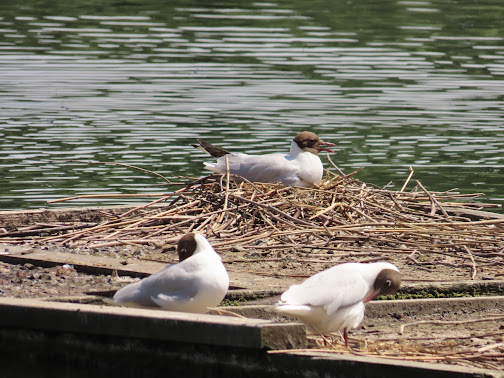Among the pantheon of great photography reserves, one site sits above all others in Suffolk. Lackford Lakes is by far the best place to visit if you have a need to photograph birds. No matter if the birding is lacklustre, as it usually is at Lackford, I always return with some decent shots, and when you're writing a blog that's a god send. However although Lackford is a good reserve, its not really the place to go and see the rarer birds. But despite this, the site is a flagship reserve for the Suffolk Wildlife Trust, and is very popular with birdwatchers, experienced or novice.
Being a hot day in June, things were pretty lazy, as you would expect. The usual water birds of Summer were present with nothing unusual, the sort of out of bird I hanker after. Lackford Lakes are a series of large lakes, man made but natural in appearance, with reed or tree bordering the water. The lakes are reserved for wildlife, with no fishing or any other kind of disturbance, which is great when compared with some of the fishing lakes I visit locally where wildlife is seen as something to be destroyed, not protected.
The central lake is the Slough, which has a mixture of islands and large areas of reeds, it seems to attract the most birds at Lackford. As with most lakes there were a couple of pairs of TUFTED DUCK, and small flocks of moulting GADWALL hanging around the water. A SHELDUCK brood of one single duckling was present. Away from the breeding birds small numbers of LAPWING were present, and believe it or not, these birds are return migrants, its a strange quirk of nature that Autumn migration starts in mid June, when it feels like high summer. Lapwings nest early, and finish raising young by mid June, but these birds will be failed nesters, or those that didn't manage to find a mate, so are the first to return. A CUCKOO was calling and I eventually saw it in flight, the best time to see them is when they stop singing, which means they are moving about. Throughout the reserve today the sound of 'cuckoo cuckoo' rang out across the site, creating such a great soundtrack to the day. A male MARSH HARRIER flew over the hide, quartered the reeds before settling down on a bale of reeds to rest awhile. They are a relatively new nesting bird on the Lakes, its a testament to modern conservation efforts that this bird has increased to so such a large population from just a single pair in the 1970s.
A feature of the lakes in mid summer is the flock of moulting SWANS present on the Sailing Lake. This year however, numbers were around half what they usually are, with only thirty birds present on the water. The nice weather had enticed some sailors out with a few dinghies on the water, this is the only lake in which there is any sailing, every other one is reserved for wildlife.
Lackford isn't particularly that bountiful for breeding birds, for some reason despite all the plentiful habitat there isn't the sort of birds you think would be present. The usual birds that nest on gravel pits were present. A pair of GREAT CRESTED GREBES were nesting on Long Reach with another brood on Plover Lake. The young birds are called "humbugs" for their stripey heads, they have the nice habit of riding on their parent's back, a little head popping up from the adult's feathers. A paltry single brood of COOT were present on the Slough, and two broods of SWANS again on Long Reach and Plover Lake. A sweet brood of five tiny LITTLE GREBES were present on Long Reach, with an older fledged bird on the Slough.
The various rafts around the lakes, I think put out for nesting terns, were of course taken over by BLACK HEADED GULLS, with various oldish chicks begging their parents for food. A pair of COMMON TERNS did manage to find room to raise two nearly fledged young on a raft on Hawker Pool.
Being high summer the smaller birds were a lot less noticeable today, as they were busy raising families, the parents had no time to stop for me, coming to and fro from deep cover in some hard to find nest. A KINGFISHER was briefly on Wilson's Flood which flew across the lake before perching distantly at the very back on a tree. Plenty of REED WARBLERS were present around the lake fringes often coming and going from the nests, providing snatches of views before disappearing again.
So a not a particularly great day for birds but that's not the point really. It has been a month or so since I've done any serious birding, and it was just so good to get out into such a peaceful, tranquil place. The face of birdwatching is always about that pursuit of the rare bird, the twitcher, but sometimes its just good to go out to bird for birding's sake. Anyway I should have some more free time soon and should be able to get out more, and of course I shall write about them on this blog.































